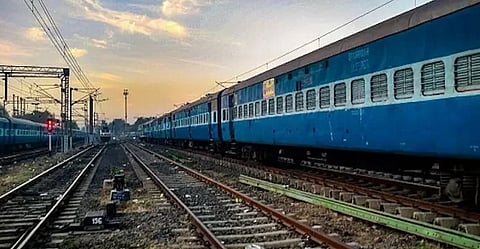
- Home
- Live Blog
- Breaking News
- Top Headlines
- Cities
- NE News
- Sentinel Media
- Sports
- Education
- Jobs

The derailment of four coaches of a passenger train after it hit a goods train at Ajmer in Rajasthan has put the spotlight on the issue of railway safety in India. As Indian Railways has embarked on an ambitious plan to introduce 3000 new trains on its network in the next four to five years, Monday’s accident is an alarm bell for inadequate passenger safety. India takes pride in rolling out Kavach—an indigenously developed Automatic Train Protection (ATP) system. High cost of installation of Kavach continues to be a challenge in expansion to wider length of railway track, more stations and locomotives. Information furnished by the Railway Ministry in the parliament shows that as of February, Kavach has so far been deployed on a 1465-km train route and 139 locomotives on the South Central Railway. The cost for the provision of trackside equipment, including station equipment, for Kavach is approximately Rs. 50 lakh per km, and the cost for the provision of Kavach equipment on locomotives is approximately Rs. 70 lakh per locomotive. The total route length of the Indian Railways is about 68,000 km, while the total length of running track (i.e., the length of all tracks between two points of the route) is more than 99,000 km. Presently, Kavach tenders have been awarded for the Delhi-Mumbai (including Ahmedabad-Vadodra Section) and Delhi-Howrah (including Lucknow-Kanpur Section) corridors (approximately 3000 route km). A part of these sectors (around 534 route km) passes through Gujarat and (around 943 route km) through Uttar Pradesh. The figures put in perspective the pace of Kavach installation and lay bare the safety gaps. The government claims that Kavach is a highly technology-intensive system that requires safety certification of the highest order. Kavach aids the loco pilot in the train running within specified speed limits by automatic application of brakes in case the loco pilot fails to do so and also helps the train run safely during inclement weather, the parliament was told. The first field trials on the passenger trains were started in February 2016, and subsequently, Kavach was adopted as a National ATP system in July 2020. Implementation of this ATP involves the installation of Station Kavach at each and every station, the installation of radio frequency identification tags throughout the track length, the provision of Loco Kavach on each and every locomotive, and laying optical fibre cables throughout the section. Images of the tragic triple train mishap at Balasore last year, in which 291 people lost their lives and more than 800 passengers were injured, have still not faded. Such lurking danger pushes the debate on choosing between new trains and securing the entire railway network with Kavach and other safety measures to the centre stage of policy discourse. The wiser choice is to go first for safety enhancement, but rushing to a conclusion is easier said than done because of pressing priorities. The introduction of new trains is a necessity due to the increasing pressure on railway passengers across the country. Railways, as a mass transit system, have a crucial role in decarbonising transport systems to meet climate goals. More passengers and goods being transported by railways can keep demand for fossil fuel for private cars, trucks, and other carriage vans in check. Till February, about 94% of the country’s Broad Gauge network has been electrified, and Indian Railway is well on track to complete 100% electrification of its tracks, which is a significant achievement in decarbonising the railway network. The introduction of new trains to facilitate the travel of more passengers by train, therefore, remains a key priority for meeting the country’s climate goals. As efforts to decarbonise personal mobility solutions as well as goods transport through the introduction of electric vehicles and green fuels like compressed natural gas, liquefied natural gas, and green hydrogen continue, the introduction of new trains can be planned keeping in mind the safety priorities and fund requirements for Kavach and other safety systems. Official data shows that India added 5,200 km of new tracks last year, which is equivalent to the entire railway network of Switzerland. In the past ten years, 26,000 km of track have been added, with a total investment of Rs 1.08 lakh crore. This is indicative of the fast-paced expansion of the railway network in the country, but it also increases safety concerns. Earmarking a proportionate amount of budgetary allocation for pushing safety measures with equal priorities is critical to making train journeys safer. During the period from 2014–15 to 2023–24 (up to October 31, 2023), altogether 748 persons lost their lives and 2050 were injured in train accidents involving loss of human life, injuries, loss of railway properties, and interruption in rail traffic, while during the period from 2004–05 to 2013–14, a total 904 persons lost their lives and 2831 were injured. However, the choice between news trains, new tracks, and safety systems must not be determined by the statistics. Ensuring that every single train journey is safer is the need of the hour.